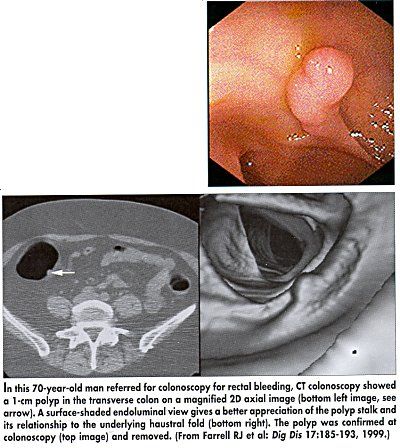Virtual Colonoscopy Promising for Colon Cancer Screening
SAN DIEGO-Virtual colonoscopy is an accurate screening tool for colorectal cancer in lesions greater than 10 mm with good patient tolerance, Richard J. Farrell, MD, said at the American Gastroenterological Association meeting held during the Digestive Disease Week conference.
SAN DIEGOVirtual colonoscopy is an accurate screening tool for colorectal cancer in lesions greater than 10 mm with good patient tolerance, Richard J. Farrell, MD, said at the American Gastroenterological Association meeting held during the Digestive Disease Week conference.
Dr. Farrell, of Beth Israel Deaconess Hospital, Boston, said that virtual colonoscopy (CT colonoscopy) employs thin-section, helical CT to generate high-resolution 2D axial images and 3D endoluminal images. The 2D image is used first, and, if a questionable lesion or polyp is observed, the image can be switched over to 3D.
In collaboration with Dr. Martina Morrin of the hospitals radiology department, he recruited 100 patients at high risk for colorectal cancer and polyps, all around the age of 60. All underwent CT colonoscopy immediately prior to elective complete colonoscopy.
The patient requires no sedation with CT, unlike conventional colonoscopy, which requires conscious sedation, Dr. Farrell said.
Using conventional colonoscopy, 45 patients had normal findings. In the other 55 patients, researchers found 88 polyps and 13 masses, including 9 carcinomas, he said.
CT colonoscopy identified 12 (90%) of the 13 masses, all of which were greater than 20 mm in diameter; 28 (92%) of 31 polyps that were greater than 10 mm in diameter; 15 (65%) of 23 that were 6 to 9 mm; and 12 (35%) of 34 that were 5 mm or smaller. There were 11 false-positive findings of polyps and three false-positive findings of masses, resulting in a specificity of 90%. The majority of false-positive tests occurred in either poorly prepped or underdistended colons.
At 0 and 24 hours, patients reported similar scores for pain and discomfort. Patient tolerance was an important component of this study, Dr. Farrell said. There was no significant difference in pain, embarrassment, or discomfort, but more patients preferred the conventional colonoscopy because they preferred to be sedated.
For CT colonoscopy to be as cost-effective as conventional colonoscopy, he said, it would need to be less than half the price of the conventional technique or need to attract considerably more patients for screening than colonoscopy.

CT colonoscopy showed excellent sensitivity and specificity for the detection of lesions 10 mm or larger in diameter, but missed one third of polyps 6 to 9 mm in diameter, he concluded. The best test, the gold standard, he said, remains conventional colonoscopy. CT is a good diagnostic tool, but you cant remove tissue, so patients with polyps prefer conventional colonoscopy. He added that large prospective trials comparing CT with conventional colonoscopy in a screening population are required.